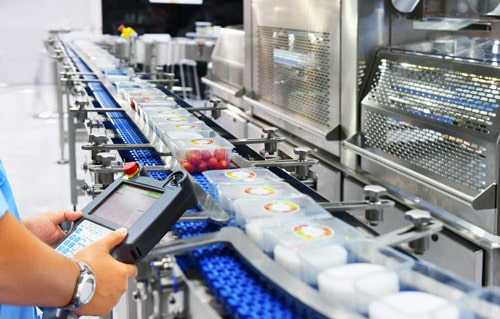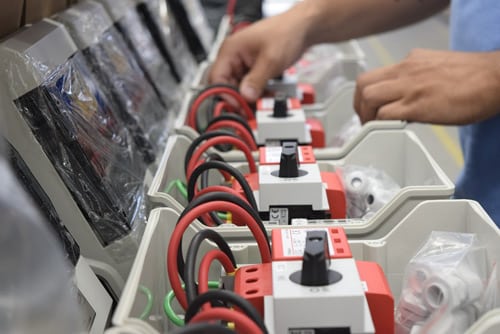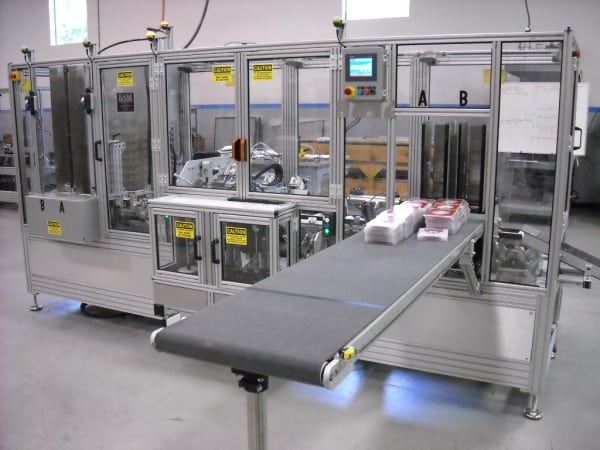
For most packaging automation systems, companies can achieve a return on investment (ROI) in under a year. As with production lines, putting together automated systems for packing involves considerable thought, from design stage through to a completed system. While new technologies are changing what automated packaging machines can do and how they work within other parts of production, investments in them should be weighed against the benefits they bring.
Benefits of Packaging Automation Systems
These days, most packaging involves some form of automation, as manual packing operations take considerably longer and require a larger workforce. Automation can refer to relatively simple conveying equipment, industrial robotics that put goods on pallets or even Internet of Things (IoT) devices that read and track through the use of smart labels. Installing packaging automation systems can make worksites safer, improve quality and increase overall productivity by eliminating the need for human labor in repetitive tasks and smoothing workflow to increase output.
Three simple benefits from packing automation systems include:
- Diminishing the risk of repetitive strain injuries, as machines take over the repetitive tasks that cause them.
- Improving production rates by speeding up packaging operations, which in turn allows production machinery to work at full capacity.
- Removing potential bottlenecks within the packaging process by eliminating the chance of human error, resulting in less downtime.
Semi-Automated or Fully Automated Packaging Systems
Some manufacturers may find it better to only automate certain tasks, at least in the initial stages of developing an automated system for packing, and consideration should go first to areas where bottlenecks occur as these will benefit most. While automated equipment generally makes packaging systems more efficient, there may be unforeseen drawbacks, so first concentrating on automating processes that will most increase productivity is best.

Fully automated packaging systems require contingency plans in case of breakdowns or other incidents that bring machinery to a halt, and keeping some processes manual can mitigate this. Yet overall, packaging automation systems will increase throughput markedly.
Creating Intelligent Systems with IoT
Though use of IoT devices and software in the packaging industry is just starting to catch on, as with other sectors IoT technology will soon become more widely used. Along with cutting packaging costs, automation combined with IoT technology helps with logistics operations, optimizes inventory control, improves customer service and makes branding easier. It can also reduce waste and defects in packaging while increasing the speed and accuracy of the entire packing process.
One particularly useful part of packaging automation systems that smart technology can enhance entails identifying why problems occur within the packaging process. Smart technology also makes understanding inefficiencies easier through the use of pattern recognition algorithms. Just as IoT technology now does in production, smart devices using artificial intelligence (AI), machine learning (ML), big data and analytics software can also help track products through the packaging stage and beyond.
Packaging Stages
Whether a system deals with semi-automated or automated packaging systems, there are three stages in which automation can improve packing quality, speed and efficiency.
These stages are:
- Primary packaging: This is the packaging in direct contact with the product, and its main purpose involves protecting the packaged merchandise, along with providing consumers with information about the product, such as quantity or size, ingredients, expiration date, where it was manufactured and product composition.
- Secondary packaging: The next packaging machinery puts the wrapped product into a secondary container, such as a cardboard box, or wraps it in plastic to ensure retailers or direct customers receive product in counter-top display units, retail-ready packaging or shelf-ready packages.
- Transit packaging: Also called “tertiary packaging”, this third stage along the packaging line places products within larger containers and puts these on pallets for transport and distribution to retailers or end users.

Parts of Packaging Automation Systems
Technology used to pack products is the first part of the coordinated system of logistics that prepares goods for shipping, storage, sale and end use. Understanding the aspects of how packaging serves manufacturers, distributors, retailers and consumers will assist when looking into what parts of the packaging process can most efficiently be automated.
Packaging is used for the following:
- Contains and protects products from damage throughout the supply chain.
- Helps preserve perishable products during transport.
- Informs consumer and retailer about contents, such as date and place of manufacture, quantity or size, weight, tracking barcodes and safety guidelines.
- Provides a means to market products on store shelves directly to retail customers by presenting products to consumers through use of an inviting appearance.
Putting together packaging automation systems involves an array of machinery structured for specific purposes that input information in order to regulate product outputs through the use of automated control equipment.
Functions of packaging automation machinery:
- Input devices – consisting of such things as switches and sensing devices – gather system information about the status of conveying equipment and the objects moving along it, feeding this data to a programmable logic controller (PLC).
- The PLC controls the entire packaging automation system, using the information from sensors to make decisions on the speed and quantity at which items are packaged prior to sending orders on to the part of the system that controls output.
- Output devices are the actuators – the relays motors and solenoids – that convert electrical signals into actual motion in order to move products through the automated packaging system, and includes relays, motors and solenoids.
Conveying

A few common types of automated conveying machines used for packaging include:
- Chain conveyors use chains instead of belts to drive each roller and are the most powerful types of conveying machines; these conveyors suit reversible operations and heavy-duty applications, using a bar to keep the chains engaged.
- Conveyor belts consist of loops made from flexible material that mechanically link two or more shafts that rotate, most often in parallel, and involve at least two pulleys – sometimes called drums – that create an endless loop to transport packages along it.
- Line shaft roller conveyors use motors that control rollers via a rotating shaft, with each roller belted to this powered shaft and separately connecting to the line shaft with drive spools and belts; these conveyor systems can power straight and curved rollers for over 100 feet, and can be reversed directionally.
- Mobile line shaft conveyors are portable conveying machines that can be arranged to achieve multiple configurations and allow for easy repositioning for different applications.
Automated Sensors
Sensors measure specific characteristics of objects or systems throughout the packaging process. Though they can be mechanical, these days most automated sensors use electronic signals to pass along information that can improve efficiency, quality and safety. Many modern sensors connect to the Internet, providing packaging automation systems with the ability to utilize IoT technology that can help with a variety of tasks. These smart sensors can detect conditions throughout the packaging process.
Sensors used in the packaging industry assist with the following:
- Controlling reel speed, torque and braking.
- Determining position of product when labeling or marking it.
- Monitoring label reel to sufficiently control labeling process.
- Tension control at various parts of the automated packaging machinery.
- Weighing individual products, batches of packaged products or fully packed pallets ready for shipping.
Many of these tasks are conducted by photoelectric or inductive proximity sensors. Photoelectric sensors can be used to detect the presence or absence of objects through use of light transmitters and photoelectric receivers, and some can even detect in the infrared range. Inductive sensors are made up of four basic parts that work together to determine when objects enter a specific space.
These are:
- Oscillator to produce electromagnetic fields.
- Coil to generate magnetic fields.
- Detection circuit that senses changes in fields when objects enter them.
- Output circuit to produce a signal when objects leave fields.
Switches
These control the flow of electricity throughout packaging automation systems, allowing equipment to turn off or on as necessary. These can be either operated by hand or automatically. Those functioning automatically require devices that force switches to change their state to allow or disallow the flow of electricity that then causes specific actions.
Toggle Switches
Two classifications for toggle switches involved in automated packaging are momentary – sometimes called “spring returns” – and non-momentary switches, which are also known as latching or on-off switches. The former only work while the actuator operates, while the latter requires the button be pressed a second time before shutting off or starting machinery.
Actuators & Motors
Automated packaging machinery uses actuators and motors to convert energy into motion. Actuators use mechanical, hydraulic, pneumatic or electrical force to make automated packing machines perform specific actions, usually in a linear motion, whereas motors convert electricity into mechanical force, typically through a rotary motion.
Some of the motors and their uses within automated packaging systems include:
- Air motors operate mechanically using compressed air to produce rotational motion to drive other rotating machinery; often used in areas where electrical current could cause an explosion, these motors provide steady torque and are used for such applications as scrap take-up from packaging machines.
- Gearmotors use either alternating current (AC) or direct current (DC), with larger motors achieving greater efficiency and producing low speeds but high torque to drive conveyors, packaging machines or other equipment.
- Linear motors use either AC or DC electro-mechanical power to produce linear motion for applications where motion varies between strokes, offering better precision and positional reaction for packaging equipment.
- Servomotors operate on an electro-mechanical basis, using either AC or DC power, in order to provide specific motion control applications, such as wrapping precise lengths of packaging film around palleted goods.
- Stepper motors are electro-mechanical mechanisms used in specific motion control applications, such as holding items in place on packaging machines, and uses AC power to position and produce rotational motions.
Relays & Indicators
Within packaging automation systems, both relays and indicators also play important roles. Consisting of electromagnets and a set of contacts, simple switches called relays operate both electrically and mechanically to pass along signals from switches to either motors or actuators. Meanwhile, indicators help human operators monitor various aspects of an automated system, offering a convenient way to observe output from a convenient or safe position, often providing readouts to indicate whether an accident, fault or other signal has occurred.
